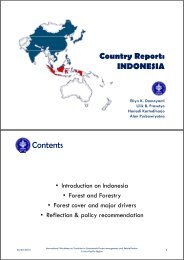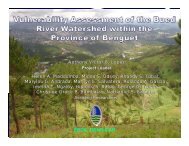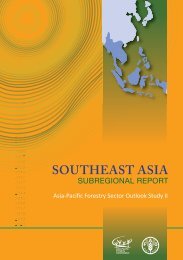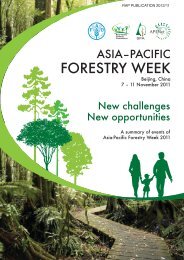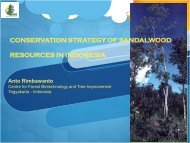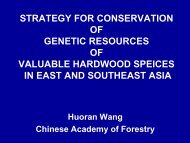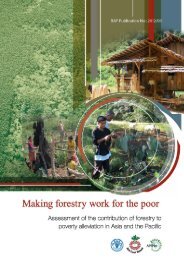Community guidelines for accessing forestry voluntary carbon ... - FAO
Community guidelines for accessing forestry voluntary carbon ... - FAO
Community guidelines for accessing forestry voluntary carbon ... - FAO
You also want an ePaper? Increase the reach of your titles
YUMPU automatically turns print PDFs into web optimized ePapers that Google loves.
<strong>Community</strong> <strong>guidelines</strong> <strong>for</strong> <strong>accessing</strong> <strong>for</strong>estry <strong>voluntary</strong> <strong>carbon</strong> markets<br />
£<br />
£<br />
Are these distribution systems perceived as equitable by<br />
local stakeholders?<br />
Do local stakeholders have prior experience with<br />
agreements or contracts regarding distribution of benefits<br />
from natural resource-based projects?<br />
VCM project developers and investors both need to have confidence<br />
in the contractual arrangements reached with local stakeholders,<br />
including community and government representatives. They also<br />
require reasonable assurance that their interests will be protected in<br />
case these arrangements break down. Forestry officials across the Asia-<br />
Pacific region are largely unused to providing such assurances to project<br />
developers and investors in the <strong>for</strong>estry sector. The growing interest in<br />
the <strong>for</strong>estry VCM may focus their attention on the importance of this<br />
issue, if these project developers and investors develop common cause<br />
at the regional level.<br />
3.1.6 Cost – benefit analysis<br />
After screening the project against all the above criteria, and any other<br />
locally-relevant parameters, project developers must begin a full and<br />
proper cost-benefit analysis. This is not only about financial costs and<br />
benefits, but must also include social and environmental issues.<br />
On the benefit side of the equation, it will not be possible to have<br />
100 percent accuracy, due to the risks outlined in section 2.3.1 (and<br />
discussed further in chapter 6). Instead, preliminary quantitative and<br />
objective estimates must be made <strong>for</strong>:<br />
• Changes in <strong>carbon</strong> stock and GHG emissions in the baseline<br />
situation;<br />
86




